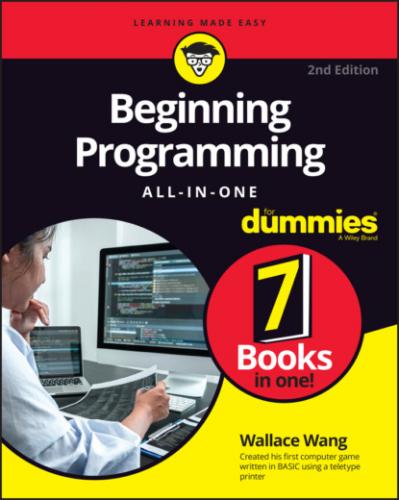19 Book 4 Chapter 1FIGURE 1-1: A bubble sort repetitively compares two adjacent items.FIGURE 1-2: The bubble sort algorithm examines the entire list of data several ...FIGURE 1-3: Selection sort repetitively moves the smallest value to the front o...FIGURE 1-4: Insertion sort only examines a list once to sort it.FIGURE 1-5: Shell sort performs multiple insertion sorts on parts of a long lis...FIGURE 1-6: Valid and invalid heap binary trees.FIGURE 1-7: Heap sort uses a tree data structure to sort and store items tempor...FIGURE 1-8: An array can mimic a heap data structure.FIGURE 1-9: Manipulating data in an array that mimics a heap.FIGURE 1-10: Merge sort breaks a long list into several smaller lists and then ...FIGURE 1-11: Quick sort repetitively divides a large list into two smaller list...
20 Book 4 Chapter 2FIGURE 2-1: The speed of sequential search depends directly on the size of the ...FIGURE 2-2: Sequential search can be made faster by searching from either the f...FIGURE 2-3: Block searching can speed up a sequential search on sorted data.FIGURE 2-4: Binary searching divides a list in half until it eventually finds i...FIGURE 2-5: Interpolation searching tries to jump straight to the approximate l...FIGURE 2-6: Fibonacci numbers divide and search a list more efficiently than a ...FIGURE 2-7: Comparison of hash tables and indexes.FIGURE 2-8: Clustered indexes physically rearrange data, whereas unclustered in...FIGURE 2-9: A tree can analyze the best possible move.FIGURE 2-10: Assigning values to possible moves helps the computer evaluate the...
21 Book 4 Chapter 3FIGURE 3-1: Sequential search examines every character.FIGURE 3-2: The Boyer–Moore algorithm skips over partially matched characters.FIGURE 3-3: The Rabin–Karp algorithm searches for hash values.FIGURE 3-4: The Shift Or algorithm creates an array of matching characters.FIGURE 3-5: The Shift Or algorithm creates a two-dimensional array.FIGURE 3-6: A finite state machine consists of nodes and arrows.
22 Book 4 Chapter 4FIGURE 4-1: Reconstructing the original data from the BWT transformation.FIGURE 4-2: Uncompressing data requires using a dictionary to replace codes wit...FIGURE 4-3: The LZ77 algorithm replaces redundant data with pointers.FIGURE 4-4: The LZW algorithm stores increasingly larger strings as numbers.FIGURE 4-5: Comparison of compressed graphic images.
23 Book 4 Chapter 5FIGURE 5-1: How a stream cipher works.FIGURE 5-2: The electronic codebook encrypts blocks of data separately with the...FIGURE 5-3: Cipher-block chaining uses the output from one block as the input f...FIGURE 5-4: A single password can encrypt and decrypt a message.FIGURE 5-5: Public keys encrypt data, and private keys decrypt data.FIGURE 5-6: Public-key and private-key encryption can work together.
24 Book 5 Chapter 1FIGURE 1-1: HTML can create six different headings.FIGURE 1-2: You can specify text to appear center- or right-aligned.FIGURE 1-3: The <th> and </th> tags define the headings for the...FIGURE 1-4: The <tr> and <td> tags define new rows and data for...FIGURE 1-5: The <caption> and </caption> tags define text to ap...FIGURE 1-6: The colspan attribute lets text expand across multiple columns.
25 Book 6 Chapter 5FIGURE 5-1: A storyboard lets you visually design a user interface.FIGURE 5-2: The parts of a SwiftUI program.FIGURE 5-3: Modifiers affect a View displayed in the Canvas pane.FIGURE 5-4: State variables let changed data appear in multiple locations autom...FIGURE 5-5: Swift allows Unicode characters to be used in variable names.
26 Book 6 Chapter 6FIGURE 6-1: Adding properties can change the appearance of the Text widget.FIGURE 6-2: The Expanded widget inside the Row widget can space items apart.FIGURE 6-3: The Column widget arranges widgets vertically.
27 Book 7 Chapter 1FIGURE 1-1: A free-form database can store randomly structured information.FIGURE 1-2: A flat-file database stores data in fields and records.FIGURE 1-3: A relational database is divided into tables.FIGURE 1-4: Flat-file databases must store duplicate data in separate files.FIGURE 1-5: Tables separate data into pieces.FIGURE 1-6: Relational databases let you combine data from different tables.FIGURE 1-7: The Select command retrieves a single record or tuple.FIGURE 1-8: The Project command retrieves selected columns or attributes.FIGURE 1-9: The Join command matches two or more tables together.FIGURE 1-10: The three parts of a database program.
28 Book 7 Chapter 2FIGURE 2-1: A bioinformatics program can help you search through large amounts ...
29 Book 7 Chapter 3FIGURE 3-1: Firewalls can block ports or certain programs from accessing a netw...
30 Book 7 Chapter 4FIGURE 4-1: A neural network.FIGURE 4-2: How a neuron processes and outputs a value.
31 Book 7 Chapter 5FIGURE 5-1: Constraints define the placement of UI items on a screen.FIGURE 5-2: Virtual keyboards can adapt to the user’s needs.
32 Book 7 Chapter 6FIGURE 6-1: Visual scripting lets you create a program by connecting nodes in a...
33 Book 7 Chapter 7FIGURE 7-1: A virtual machine lets a program run on multiple operating systems.
Guide
1 Cover
4 Table of Contents
6 Index
Pages
1 i
2 ii
3 1
4 2
5 3
6 5
7 6
8 7
9 8
10 9
11 10
12 11
13 12
14 13
